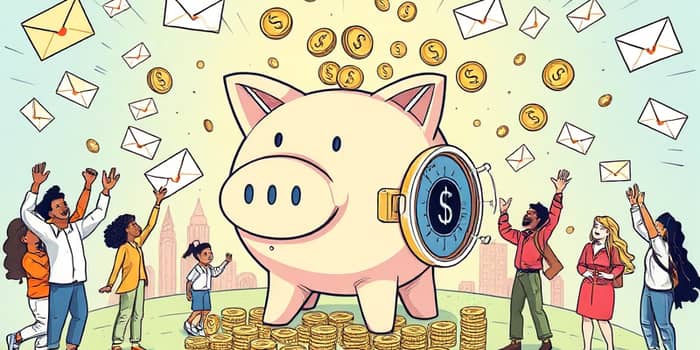2025 presents a unique opportunity to transform your financial future with fresh strategies that go beyond the traditional piggy bank. By combining automation, gamified challenges, and evidence-based behavioral tips, anyone can elevate their saving game. This article explores cutting-edge methods backed by 2025 trends, giving you a roadmap to achieve both small wins and substantial nest eggs.
Automate Your Savings for Consistency
One of the simplest yet most powerful strategies is to put your savings on autopilot. When you set up automatic transfers each payday, you remove the friction of manual decisions. Whether you direct deposit a portion of your paycheck or schedule recurring transfers, automation builds momentum without daily reminders. Over a year, saving just $200 per month can yield $2,400 in annual savings effortlessly.
Automation not only fosters consistency but also leverages psychological momentum. You’ll start to view your savings as untouchable, shifting the mindset from “I might save later” to “My savings are secured.” This approach is perfect for individuals who want consistent savings without monthly decisions and prefer to avoid the temptation to spend available cash.
Gamified Challenges to Energize Your Savings
Gamification turns saving money into an engaging activity that taps into our natural reward systems. In 2025, variants of classic challenges are gaining traction, each designed to keep motivation high and boredom at bay.
- the 100 Envelope Challenge method: Number envelopes 1–100, place the corresponding dollar amount inside each envelope, and open one daily until you accumulate $5,050 in about three months. Shuffling envelopes adds excitement and budgeting flexibility.
- 52-Week Money Challenge: Start with $1 in week one, increase savings by $1 each week, and finish with $1,378 saved at the end of the year.
- No-Spend Challenge: Designate certain days for zero discretionary spending. Save the amount you would have spent and watch your balance grow.
- Don’t Buy Challenge: Create a year-long list of unnecessary items (such as takeout coffee or fast fashion) and vow to avoid them. Reflective planning strengthens commitment.
Participating in these challenges provides a sense of accomplishment as each milestone is reached. The mix of structure and playful competition offers both financial and emotional rewards, making saving less of a chore and more of an adventure.
Behavioral and Micro-Savings Techniques
Behavioral science shows that small adjustments can trigger big financial shifts. Simple habit tweaks and micro-savings rules can accumulate substantial gains over time.
- Subscription Audit: Review streaming, fitness, and meal-kit services quarterly. Cancel unused plans and redirect funds to your savings.
- Break Expensive Habits: Identify costly routines—like daily lunch takeout or designer coffee—and replace them with budget-friendly alternatives, banking the difference each time.
- The $20 Rule: Whenever you receive any income—side gig earnings, tax refunds, or gifts—instantly save $20. This approach can lead to impressive savings in a short period.
- Shop Smarter: Use cashback platforms and coupon apps before purchases. A few minutes of planning can generate hundreds of dollars annually.
By reframing minor transactions as saving opportunities, you gradually retrain spending habits. Over months and years, these micro-savings compound into noteworthy sums, proving that no contribution is too small to matter.
Advanced Strategies and Expert Tips
Once foundational techniques are in place, it’s time to explore advanced maneuvers that sharpen your financial edge. Tackling debt, optimizing budgets, and leveraging professional tools can significantly accelerate progress.
- Pay Down High-Interest Debt: Focus on credit cards with APRs around 21.5%. By prioritize eliminating high-interest credit card balances, you free up cash flow and reduce future interest charges.
- Budget Reviews: Conduct monthly or quarterly budget audits to adapt to seasonal expenses and evolving goals. This practice helps you maintain financial flexibility and clarity.
- Debt Consolidation: Consider combining multiple debts into a single loan with lower interest rates, lowering payments and simplifying repayment schedules.
- Insurance and Plan Audits: Review insurance policies and mobile plans annually. Switching to more competitive offerings can unlock hidden savings opportunities.
- Emergency Fund Growth: Allocate a percentage of windfalls or raises to bolster your safety net. A robust emergency fund guards against unplanned costs.
By layering these expert-driven tactics onto your foundational habits, you forge a resilient savings ecosystem. Each element—from debt management to periodic plan reviews—ensures that your financial progress remains sustainable and dynamic.
Summary of Techniques and Impact
Conclusion and Next Steps
Transforming your saving habits in 2025 is entirely within reach. By blending automation, gamified challenges, behavioral tweaks, and expert guidance, you create a powerful framework for financial growth. Start with one or two strategies that resonate, then gradually expand your toolkit. With consistency and mindfulness, even modest efforts can lead to noticeably life-changing financial outcomes.
Remember, the journey to robust savings is not a sprint but a sustained adventure. Embrace the process, celebrate milestones, and adjust as you learn. Your future self will thank you for the steps you take today.
References
- https://www.fbfs.com/learning-center/money-saving-challenges-to-try
- https://quailcreek.bank/strategies-for-saving-more-in-2025/
- https://www.pnc.com/insights/personal-finance/save/money-saving-challenges.html
- https://www.quicken.com/blog/14-best-ways-to-save-money/
- https://www.dailycardinal.com/article/2025/01/looking-to-save-money-try-the-dont-buy-method-for-2025
- https://www.youtube.com/watch?v=KrQBtmB_GAM
- https://www.morganstanley.com/articles/financial-planning-new-year-financial-resolutions










